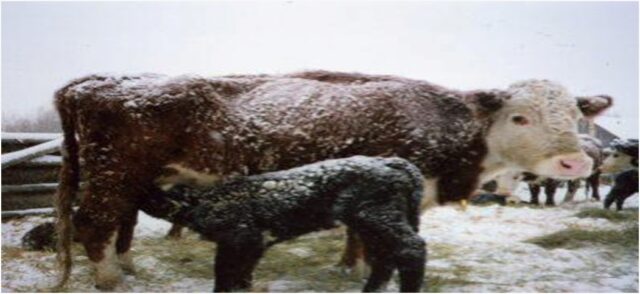
Winter Stress in Dairy Cattle
Introduction
Cold winter weather, characterized by freezing temperatures, snow, and strong winds, presents significant challenges for managing dairy cattle. When temperatures fall below the lower critical temperature (LCT), the metabolic demands on cows increase, potentially leading to reduced milk production, health issues, and reproductive challenges. Dairy cows, being warm-blooded, must maintain a core body temperature of around 38°C, and exposure to cold stress disrupts their normal metabolic processes. This article explores practical methods to reduce the negative effects of cold stress and maintain optimal performance and well-being in dairy cattle.
Impacts of Cold Stress on Dairy Cattle
Direct Effects
- Milk Production: Cold stress can decrease blood flow to the udder, reducing milk production. Cows may lose up to 2 kg of milk per day when exposed to cold conditions.
- Reproduction: Cold weather can delay calving, disrupt follicle development, and reduce fertility, leading to longer calving intervals. Inadequate nutrition during winter exacerbates these reproductive problems.
- Body Condition: Cows with better body condition are better insulated against cold stress. However, the increased energy demands during winter can deplete body reserves, resulting in weight loss and reduced reproductive performance.
- Health Problems: Cold stress can lead to respiratory infections, frostbite, and a weakened immune system. It may also cause metabolic stress and increase the risk of postnatal mortality.
Indirect Effects
- Feed Availability and Quality: Winter reduces the availability and quality of forage, and the crude protein content of feed typically declines during cold months.
- Shelter Conditions: Poorly maintained or overcrowded barns expose cows to drafts, increasing the risk of respiratory illnesses. Muddy conditions increase the risk of foot rot and other diseases.
- Water Scarcity: Freezing temperatures can reduce access to water, limiting intake and negatively impacting milk production and overall health.
Responses of Cattle to Cold Stress
Physiological Adaptations
Heat Conservation: Cattle conserve body heat through vasoconstriction, which reduces heat loss from the skin.
Hair Coat: Cold temperatures trigger increased hair density and piloerection (hair standing on end), which enhances insulation by trapping air close to the body.
Heat Production: Cattle increase their feed intake and use mechanisms like shivering and non-shivering thermogenesis to generate heat.
Hormonal Adjustments
Non-Shivering Thermogenesis: Hormones like thyroid hormones stimulate brown fat metabolism, increasing metabolic rates to generate heat without producing movement-related energy (ATP).
Strategies for Mitigating Cold Stress
Nutritional Management
Energy-Rich Diets: To meet the increased energy demands of winter, provide feeds that are high in energy (77% TDN) and protein (17.5% CP).
Supplementary Feeding: Add concentrates, silage, and other supplements like feed blocks to ensure adequate nutrition, especially when forage is scarce.
Improved Forage Utilization: Enhance straw digestibility using techniques like chaffing and urea treatment to improve the nutritional quality of available forage.
Shelter Management
Well-ventilated, Draft-free Barns: Ensure barns are free from drafts while maintaining adequate ventilation to prevent respiratory issues.
Additional Warmth: Utilize heat lamps, calf jackets, and curtains to provide extra warmth to young or vulnerable animals.
Snow Removal and Calving Season Adjustments: Regularly clear snow and consider delaying calving to reduce the stress on cows during extreme winter conditions.
Water Management
Water Temperature: Keep water temperature above 8°C using heaters to encourage drinking. Adequate water intake is critical for maintaining productivity.
Mud and Hygiene Management
Clean and Dry Shelters: Prevent the accumulation of mud and water in barns to reduce the risk of foot rot and other infections. Keep bedding dry and comfortable to help maintain body heat.
Health Management
Vaccination and Deworming: Ensure cows receive proper vaccinations and deworming treatments to reduce the risk of infections.
Exercise and Weight Management: Provide exercise by moving feed and water locations to prevent obesity and maintain overall health.
Frostbite Prevention: Use teat dips and other protective measures to prevent frostbite on sensitive areas like teats and ears.
Conclusion
To ensure the health, productivity, and overall well-being of dairy cattle during winter, it is essential to keep them within their thermoneutral zone. By adopting effective strategies such as providing energy-rich diets, improving shelter conditions, maintaining hydration, and ensuring proper health management, dairy farmers can mitigate the adverse effects of cold stress. Proactive management and careful resource allocation are crucial to ensure the welfare of dairy herds during the harsh winter months.
References
1.https://scholar.google.co.in/scholar_url?url=https://www.researchgate.net/profile/Ashaq-Manzoor/publication/331224607_Mitigating_winter_vagaries_in_dairy_animals_A_review/links/5c6d3462a6fdcc404ebf3cd9/Mitigating-winter-vagaries-in-dairy-animals-A-review.pdf&hl=en&sa=X&ei=vXhcZ8XQKMyR6rQPhb_isQU&scisig=AFWwaeb51LqnLjTHptFPE6kJxzJo&oi=scholarr
2.https://extension.umn.edu/dairy-news/managing-dairy-cattle-cold-weather
3. https://www.agriculturejournals.cz/publicFiles/145647.pdf
4.https://pmc.ncbi.nlm.nih.gov/articles/PMC10215760/
5.https://scholar.google.co.in/scholar?q=winter+stress+on+dairy+animals&hl=en&as_sdt=0&as_vis=1&oi=scholart#d=gs_qabs&t=1734113974784&u=%23p%3DeE92hh3YSB4J
6.https://images.app.goo.gl/uSV84QVxEGms5BtH9
7.https://dairy.extension.wisc.edu/articles/cold-stress-in-dairy-calves/
Abstract
The productivity and health of dairy cattle are heavily influenced by environmental conditions, particularly during the winter months when temperatures fall outside their thermoneutral zone. Cold stress increases metabolic demands, alters feed intake, and can lead to hormonal changes, increased energy expenditure, and other physiological adjustments. This article outlines effective strategies to reduce the impact of cold stress on dairy cattle, ensuring their health and productivity are optimized during the winter. Key measures include improving barn conditions, providing suitable bedding, offering energy-rich diets, and utilizing warming devices such as heat lamps and calf jackets.

Simran jeet Singh’, Shaguneet Kour and Niddhi Arora³
‘PG Scholar, Department of Veterinary Medicine
PG Scholar, Division of Veterinary Medicine
Professor, Department of Veterinary Medicine
1.3 College of Veterinary and Animal Sciences, GB Pant University of Agriculture and Technology, Pantnagar, Udhamsingh Nagar, Uttarakhand-263145

















